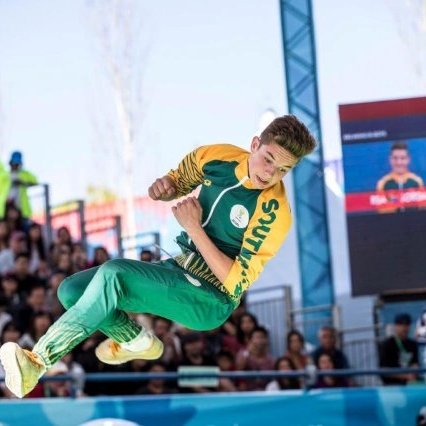click to dowload our latest edition
CLICK HERE TO SUBSCRIBE TO OUR NEWSLETTER


Published
6 years agoon
By
adminJORDAN MOSHE
Since its inception, break dancing has been a sport that has mostly remained underground. However, the International Olympic Committee announced at the end of the 2016 Rio Olympic Games that break dancing would be added to the Youth Olympic Games at this year’s event in Buenos Aires, Argentina.
Held between 6 and 18 October, the games featured 239 events in 32 sports, with a total of 206 countries competing, among them South Africa. Smith was one of the 29 young South Africans on the team, and the only one competing in the dance sport category.
Smith started dancing at the age of five. “I always loved flipping myself over,” he says. “When my mom saw that I could do it without injuring myself, she suggested I take up gymnastics. I went to lessons, but it was too hectic for me. I was also always breaking into dance, so I went for hip-hop instead, and it was a good fit.”
Smith has always had a natural sense of rhythm, and so took to hip-hop with ease. It was not until the age of 10 that he considered break dancing, and even then, he didn’t take it seriously. However, when renowned break dancing instructor and dancer Bashimane Basetloa noticed him at a local dancing competition, all this changed.
“I was 13 when Bashimane saw me competing,” says Smith. “He just came up to me and said, ‘You need to train with me’. That was it. I had been dancing in a group until then, and had never thought about focusing on solo dance with an instructor, but ended up going to his studio the next week. It was he who made me realise I could achieve something special with breaking.”
Training regularly, Smith began participating in more and more local competitions and gaining experience. He says that in spite of the seriousness he began to attach to the sport, few others really understood what he was doing. “I had to put up with ignorance and some mockery. Other boys asked me why I didn’t play soccer or rugby like them. My school didn’t really understand it either. While they mentioned me at assemblies, they didn’t recognise what I was doing as an actual sport.”
Still, Smith remained committed to his passion, and continued his training. In 2017, he came across an opportunity called Breaking For Gold, a call for youth looking to compete in a break dancing event at the Youth Olympics. Smith submitted a short video of himself dancing, and was selected to compete with four South Africans in a local break dancing battle. His prowess landed him second place, and got him to the second round in Germany in October last year.
One of 130 people competing in break dancing battles between European and African entrants, Smith was sceptical about making it through and ranking as one of the top 32 who would move on. He says, “I saw the standard of dancers around me, and didn’t expect to go through. They were all really talented.”
It turned out that he stood more than a chance. Not only did Smith land one of the 32 spaces for that round, he also earned a position in the next round with 19 others, all of whom qualified to move to the last qualifying round in Japan, before moving on to the Olympics in Argentina.
When he arrived in Japan, Smith says he expected to dance and go home shortly thereafter. “I met one of my biggest break dancing heroes, B-Boy Shigekix [Nakari Shigeyuki], while there. He was absolutely incredible. I couldn’t believe I was meeting him. Alongside him, I thought I was really only going to dance a bit, and then go home. I didn’t think I had a chance there.” When he didn’t make the top 12, Smith thought that his prediction had come true.
However, because this group could include only one representative from each country, certain participants were disqualified. Smith was the best dancer from the African continent, and so took up the 12th spot in this group. Although he didn’t feel he deserved it, he committed himself to strenuous training, devoting late nights and early mornings to practicing. On 1 October, he and his mother, Stephanie, set off for Japan, and a few days later, Smith competed in the first event of the games.
Despite his obvious talent, Smith says he felt self-conscious while dancing, especially in front of his mother. “I wouldn’t let her watch me where I could see her,” he laughs. “I also felt shy when I saw a stand full of my friends watching me compete. But when the music started, everything around me disappeared, and I could only see the dance. When I came out of it, I suddenly noticed my mom on the side, waving and encouraging me. It meant so much.”
Smith competed against Japan’s top-ranked young dancer, and in spite of losing to him, felt no resentment. “He destroyed me,” says Smith. “But it didn’t matter. All I wanted to do was show that I could be one of them, dance on their level, and not come last.” He did more than that. Smith’s performance ranked him 10th in the world, proving just how great his talent really was.
What Smith is most proud of, however, is that he is part of the movement that will result in break dancing being recognised as a sport. “It encourages more kids to take up something very different, and for the sport to gain traction in South Africa,” he says.
“The experience has taught me that anything is possible,” he says. “I am now able to see myself as among the greatest, not just striving to be one of them.”
